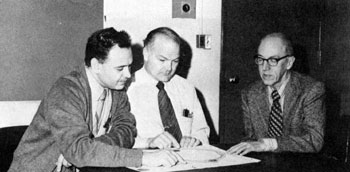Consider Use of NAL Linac, Booster for Cancer Therapy

Miguel Awschalom, Radiation Physics, Donald E. Young, who directed development of
NAL's Linac, and Professor Lester Skaggs, of the University of Chicago,
discuss cancer therapy unit proposal during recent meeting at NAL
Photo by Tim Fielding, NAL
In 1971, a proposal was submitted to study the use of the NAL linac and booster for cancer therapy. This proposal, with a number of investigators from many leading medical institutions in the Chicago area, as well as NAL participants, was submitted to the National Cancer Institute of the Department of Health, Education, and Welfare in October.
The use of protons for cancer therapy is not new. NAL's director. Dr. Robert R. Wilson, pointed out many of the advantages of using protons as early as 1946 in an article in the journal "Radiology." Research in this field developed slowly due to the lack of time on accelerators of sufficient energy to achieve the required penetration of the protons into deep tissue.
Interest in this use at NAL began in spring, 1971 with a widely quoted paper by Louis Rosen, of the Los Alamos Scientific Laboratory, at the Particle Accelerator Conference in Chicago. Dr. Rosen discussed the application of particle accelerators to other fields than physics research. Professor Lester Skaggs, of the University of Chicago and the Argonne Cancer Hospital, a distinguished scientist in medical physics, was stimulated by this talk to begin discussions with NAL staff members looking toward the use of our accelerator.
An advantage of NAL is that patients could be drawn from the whole Chicago area. The metropolitan-area population of 8 million could be expected to produce 24,000 cancer patients per year, of whom half, or 12,000 will need some kind of radiation therapy. There are seven medical schools in the area, all interested in this possibility for treatment.
Most radiation therapy has been carried out with X-rays or electron beams. Heavy particles like protons offer an advantage over X-rays or electrons in that the radiation dose can be localized much better at the site of a tumor, so that the radiation is concentrated where it is needed and does not inflict as much damage on healthy tissue on the way to the tumor. Protons have been used for cancer therapy with significant success for some time, notably at Berkeley, Harvard, and in Uppsala, Sweden. The NAL linac was busy as an injector for the main accelerator only about one-fourth of the time and could produce an ample proton beam in the remaining three-fourths of the time.
There was considerable interest in evaluating the relative effectiveness of protons, heavier ions and pi-mesons for therapy. It was possible that NAL could provide a facility for a pion beam as well as a proton beam through the use of the booster.
Dr. Skaggs sponsored an area-wide meeting in August, 1971 to organize the effort. The chiefs of radiotherapy of each of the seven medical schools responded and all actively supported the project. A symposium was held at the Laboratory on December 4, 1971 jointly sponsored by the American Association of Physicists in Medicine, the Metropolitan Association of Radiation Therapists, and NAL, with over 130 participants discussing their experience in heavy-particle therapy.
There was considerable interest in the possibility of cancer therapy at NAL. The proposal to NCI, which had Professor Skaggs as principal investigator and 15 NAL and area scientists and doctors as participants, asked for funds to carry out a study of the desirability and feasibility of such a project and to establish what equipment and facilities would be needed. A review board from NCI visited NAL in February, 1972.
Among physicians and scientists in the Chicago metropolitan area who have expressed interest in supporting the proposal were: Jaques Ovadia, Ph.D., Director, Medical Physics Section, Dept. of Radiation Therapy, Michael Reese Hospital, Associate Professor of Medical Physics, Dept. of Radiology, University of Chicago; Melvin Greim, M.D., Professor of Radiology, Director Chicago Tumor Institute, University of Chicago; Frank Hendrickson, M.D., Chairman, Dept. of Therapeutic Radiology, Rush Presbyterian-St. Lukes Hospital, Professor, Rush Medical College; Edwin Liebner, M.D., Professor and Acting Chairman, Dept. of Radiology, University of Illinois; William Moss, M.D., Director, Therapeutic Radiology, Chicago Wesley Memorial Hospital, Professor, Northwestern University School of Medicine; James J. Nickson, M.D., Chairman, Dept. of Radiation Therapy, Michael Reese Hospital, Professor of Radiology, Dept. of Radiology, University of Chicago; R. Perez-Tamayo, M.D., Professor of Radiology, Director of Therapeutic Radiology, Dept. of Radiation Therapy, Loyola Stritch School of Medicine; S. Stefani, M.D., Chief of Service, Dept. of Therapeutic Radiology, Hines V.A. Hospital, Professor of Radiology, The Chicago Medical School; Warren Sinclair, Ph.D., Director, Division of Biological and Medical Research, Argonne National Laboratory, Professor of Radio-biology, Dept. of Radiology, University of Chicago.


